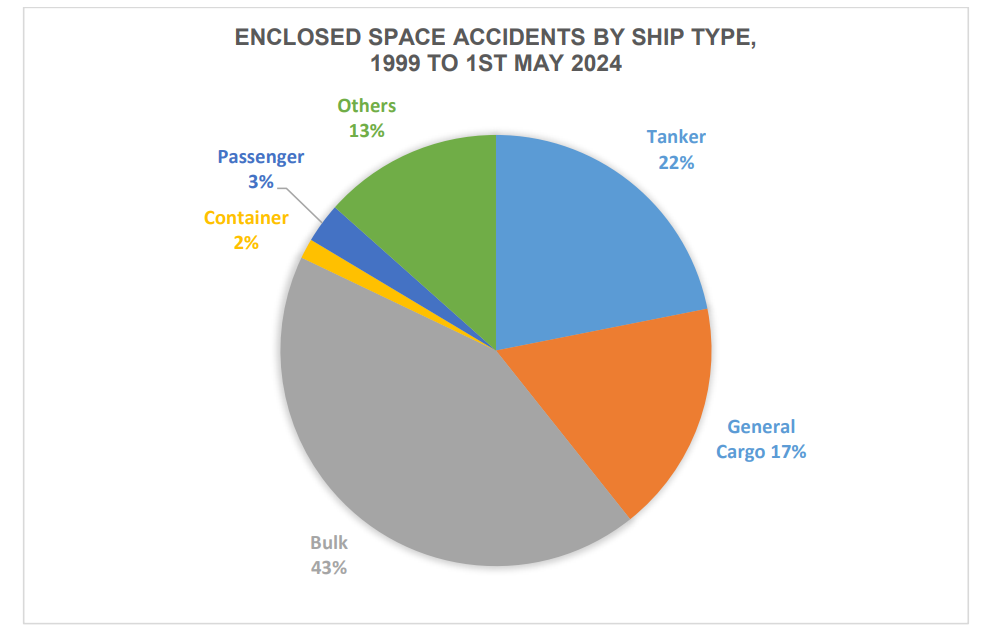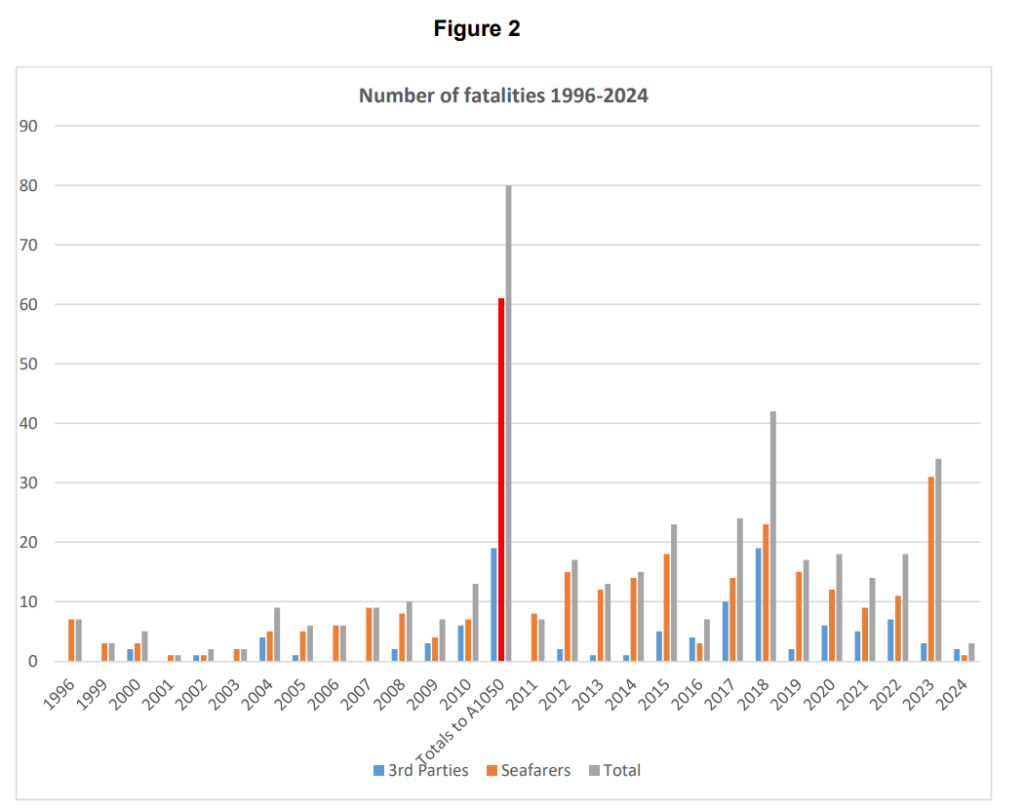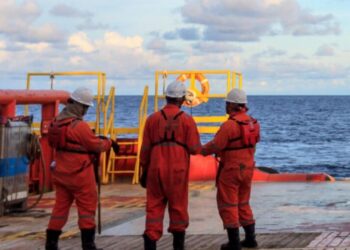During the 2024 SAFETY4SEA Athens Forum, Mike Bradshaw, Director, Fleet Management Limited, emphasized the industry’s tendency to focus on KPI compliance and short-term campaigns rather than fostering innovation in long term safety practices.
The maritime industry’s approach to safety often follows a modular approach, focusing on certain themes or campaigns for brief periods. This means that some topics may receive more attention than others, or lessons aren’t always fully embedded into the industry’s operations before moving on to the next concern. In practice, safety protocols require constant and consistent attention.
There is a recurring question: Is complacency creeping into the industry? Many instinctively argue that safety is always the top priority. However, when safety dashboards display all-green, are leaders digging deeper to identify less obvious risks? High safety scores should not lead to complacency but prompt a continued focus on underlying red leading indicators, those early signals that can prevent serious incidents.
What keeps you awake at night?
I reached out to P&I Loss Prevention, Energy Majors, Chambers of Shipping and predictive model providers and there was remarkable alignment on what is keeping them awake at night, what are the top safety concerns? The responses I received were:
- Personnel transfer falls to water
- Mooring
- Lithium-ion batteries
- Groundings due to poor passage planning
- Loss of propulsion/power/steering
- Vehicle deck safety
- Enclosed spaces
- Mis-declared cargoes in containers
Machinery damage and fire incidents
However, I find it interesting that machinery failure was not a top concern. According to Allianz Commercial, in 2023, there were 27,821 reported incidents, with machinery damage or failure leading the list at 11,506 events. Despite this being an area of concern for marine insurers, particularly considering recent high-profile events and the potential for large claims, it trails behind other concerns which cloud our attention.
Additionally, fire safety hasn’t been at the forefront of the conversation, though perhaps it should be. Over the past three years, 55 total losses have been caused by fires, and in 2023 alone, 205 fire-related incidents were reported—the highest in a decade.
Curiously, security was not on the list either, but perhaps this could be explained by the fact that most compartmentalize security as something other than safety. Alas, the reality is that over 100 vessels have been attacked by Houthis in the Red Sea and Gulf of Aden this year, and seafarers have died.
Enclosed space fatalities: an enduring crisis
One of the most alarming safety issues is the rising number of deaths from enclosed space incidents. From 1999 through August 2024, 42% of these incidents occurred on bulk carriers, compared to 23% on tankers.

The problem has worsened in recent years, with 15 fatalities in 2021, 20 in 2022, and 31 in 2023, according to IMO data.
Although efforts were made to reduce those numbers, such as the introduction of IMO Resolution 1050 in 2011 and ISGOTT6 in 2020, the impact was only temporary. Incidents declined briefly but then increased again, highlighting that the short-term focus after new regulations has not led to lasting improvements.

A recent case, reported by a flag state, involved a trainee who died after inhaling toxic gases, most likely hydrogen sulfide, while entering a cargo hold bilge. Despite mandatory training on the matter, the onboard safety culture, particularly on bulk carriers, remains a challenge. And if you are doubting the cultural aspects of this, consider that 68% of all officer fatalities were from within the onboard leadership team. The chief officer, the safety officer, is the person that’s dying the most. So, what does that tell as about safety culture onboard those ships?
Considering all this, reporting enclosed space entry incidents becomes crucial in preventing them. Only trough transparency and reporting can the industry draw lessons and proactively address any future instances.
Inadequate access arrangements and pilot fatalities
Unsafe access is another critical safety concern. Since the start of 2023, 10 pilots have died while boarding or disembarking vessels, a stark reminder of the dangers associated with unsafe access arrangements.
Despite campaigns by port state control (PSC) and safety groups, key messages are not reaching the seafarers responsible for making arrangements on ships. Unsafe practices continue to prevail, and, once again, cultural shifts within the industry are needed to make lasting changes.
The rise in fires on container ships
The fires aboard two container vessels in August 2024 brought container ship safety back into focus.
Two major fires in the space of a week during August have put container safety back in the news. While these investigations are still ongoing, the Ningbo authorities have confirmed that the cargo in the case of one vessel included lithium batteries and other highly flammable organic compounds.
Furthermore, last year alone, there were 205 fire-related incidents, and as container vessels grow larger—now carrying up to 20,000 TEU—the risks increase exponentially.
Mis-declared cargo, hazardous materials, and inadequate firefighting systems are compounding these risks. The insurance industry has called for stricter regulations, and the IMO is currently considering proposals to address these issues.
The maritime sector needs a coordinated approach to improve training and safety standards, particularly with the increased carriage of lithium-ion batteries.
Vehicle deck safety: A hazard for roro ferries
In the roro ferry sector, vehicle deck safety remains a serious issue. Hazards such as moving vehicles, poor visibility, high noise levels, and noxious fumes from vehicles contribute to a high number of accidents, sometimes with fatal outcomes. In 2021, a bosun aboard a UK-trading ro-ro vessel was fatally crushed during cargo loading operations. The forthcoming MAIB report on this case is expected to offer critical recommendations for improving safety on vehicle decks.
Furthermore, the UK’s National Maritime Occupational Health and Safety Committee has issued free guidelines for vehicle deck safety, along with the “10 Golden Rules for Vehicle Deck Workers,” under the Together in Safety initiative. These resources aim to reduce the number of incidents in this high-risk area.
Emerging risks: New fuels and environmental concerns
As the industry shifts towards decarbonization, there are new risks associated with emerging fuels such as LNG and ammonia. While the world focuses on environmental regulations, the safety implications of these new fuels must not be overlooked. HiLo data from the past three years, covering 2,500 ships, shows that fuel containment failures have led to 70 fires or explosions and one fatality. Thus, the potential consequences of introducing new fuels, particularly in the event of leaks, are significant.
Luckily, organizations such as the Global Centre for Maritime Decarbonization have begun addressing these risks, and in August 2024, they published recommendations for ensuring safe ammonia bunkering operations. However, implementation will be critical.
The need for sustained focus on safety
Safety is not a scorecard, a three-month campaign, or a color. It is a continuous commitment that must be maintained over the long term. Short-term initiatives may bring temporary improvements, but the lessons learned need to be ingrained into the industry’s operations to create lasting change.
Companies must continue to apply the same degree of innovation to safety as they do in other areas and create a culture and incentivization that encourages compliance.
The focus should remain on keeping seafarers safe and ensuring they return home to their families at the end of each contract.
The views presented are only those of the author and do not necessarily reflect those of SAFETY4SEA and are for information sharing and discussion purposes only.
Above article has been edited from Mike Bradshaw’s presentation during the 2024 SAFETY4SEA4SEA Athens Forum.
Explore more by watching his video presentation here below
































































